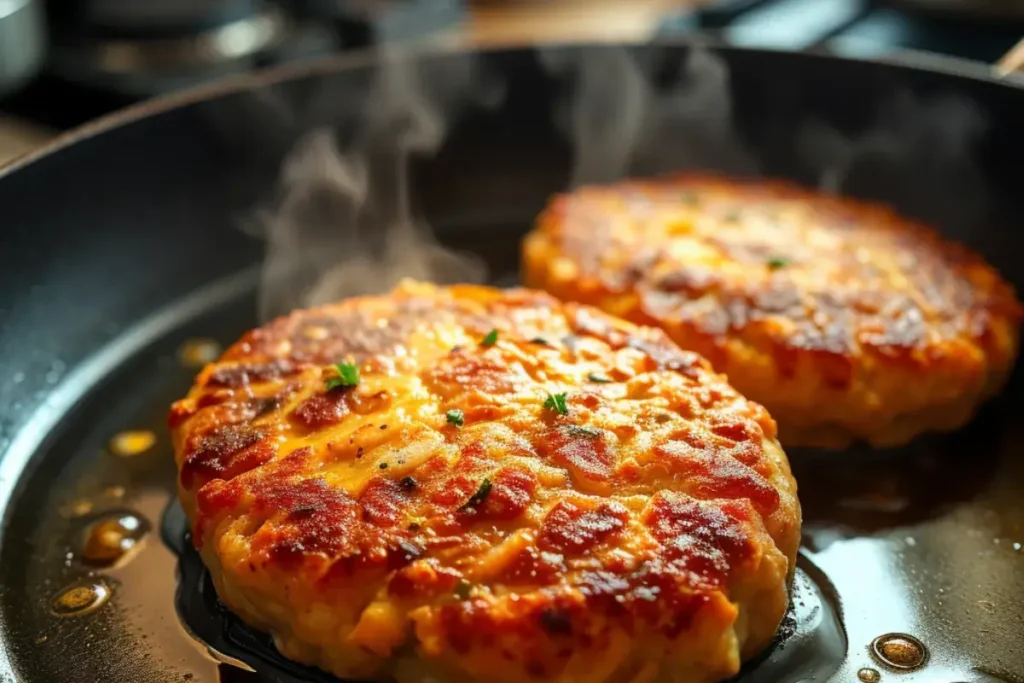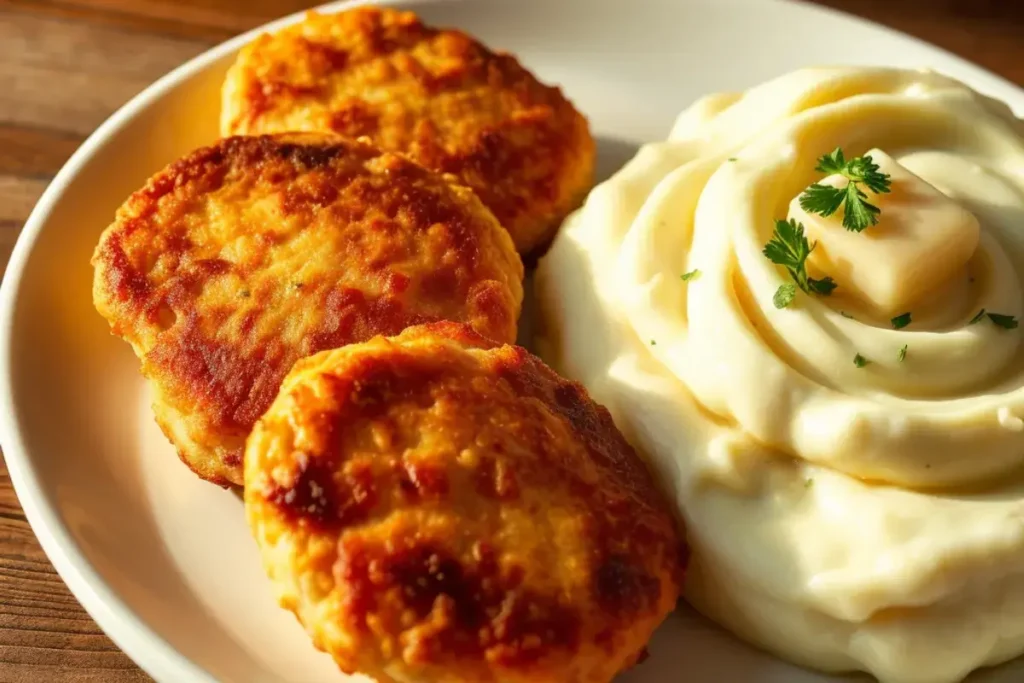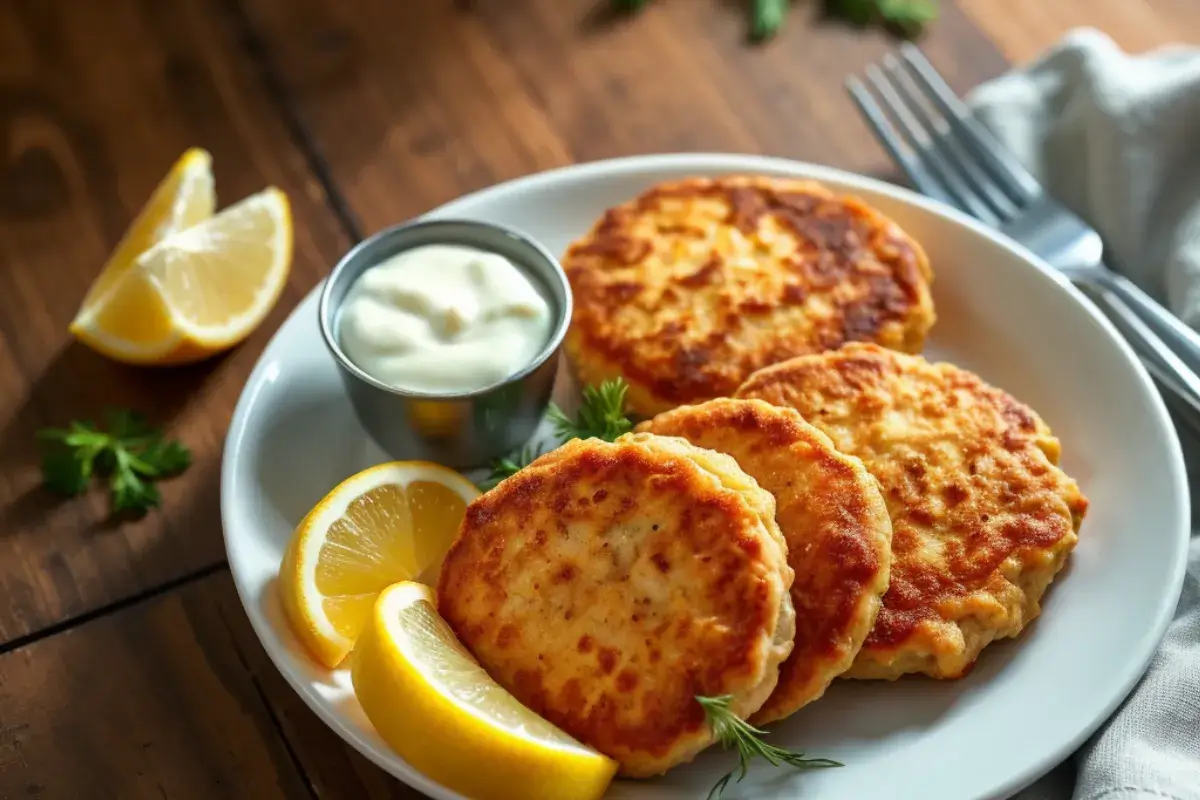Salmon patties are a delicious, versatile dish, but they can sometimes turn out mushy instead of firm and crispy. If you’ve ever had this issue, you’re not alone. There are a few key reasons why your patties may not hold their shape, and fortunately, there are simple solutions to get the perfect texture.
In this guide, we’ll walk through the most common causes of mushy salmon patties and how to fix them.
Common Causes of Mushy Salmon Patties
Excess Moisture in the Salmon
One of the main culprits for mushy salmon patties is excess moisture. If you’re using canned salmon, you might be surprised how much liquid it contains. Fresh salmon can also hold water, especially if it hasn’t been blotted dry before mixing.
- Solution: Make sure to drain canned salmon thoroughly. Press it down to remove any water, or use a fine mesh strainer. For fresh salmon, blot it with a paper towel to remove extra moisture before incorporating it into your mix.
For tips on enhancing the flavor of your salmon and preparing it for the best results, visit this guide on how to enhance the flavor of salmon.
Overuse of Wet Ingredients
Wet ingredients like eggs, mayonnaise, and sauces can make the patties too soft. Although they add flavor, adding too much liquid can lead to a soggy texture.
- Solution: It’s important to get the balance right. Consider reducing the quantity of these ingredients or adding more binders like breadcrumbs to soak up excess moisture.
Inadequate Use of Binders
Binders are key to achieving the right texture. Without enough breadcrumbs, panko, or crackers, your patties won’t hold together well. These ingredients help soak up moisture and give the patties structure.
- Solution: Use about 1/2 to 1 cup of dry breadcrumbs for every pound of salmon. You can also experiment with alternatives like almond flour or even mashed potatoes if you’re aiming for a gluten-free option. Want more ideas? Check out this resource on gluten-free binder options for useful alternatives.
Over-Mixing the Ingredients
Overmixing the salmon and other ingredients can break down the delicate proteins, resulting in a mushy texture. The more you mix, the less structure the fish will have, which leads to softer, less cohesive patties.
- Solution: Mix the ingredients just until combined. Use a light hand and fold the ingredients together gently to maintain the texture of the salmon.
Techniques to Prevent Mushy Salmon Patties
Proper Draining and Drying of Salmon
Before you even start mixing your ingredients, you need to ensure the salmon is dry. Canned salmon, in particular, needs to be drained well, while fresh salmon should be patted dry with paper towels. Too much moisture at the start can lead to mushy patties.
- Tip: Let your salmon rest in a fine mesh strainer for about 10 minutes after draining, ensuring all the liquid is gone.
Chilling the Patties Before Cooking
Another easy trick to avoid mushy salmon patties is to chill them before cooking. This helps the binders to set, firming up the patties so they won’t fall apart when you cook them.
- Tip: Place your formed patties in the fridge for at least 30 minutes before pan-frying or baking. If you’re short on time, even 15 minutes in the freezer can make a big difference.
Preheating the Pan for Pan-Frying
Pan-frying is a great way to get that crisp exterior on your salmon patties, but only if you preheat the pan properly. A cold pan causes the patties to absorb too much oil, leading to a mushy texture.
- Tip: Preheat the pan on medium heat for a few minutes. Add oil once the pan is hot, and allow the oil to heat up before placing the patties in the pan. This helps them sear properly and create a crisp outer layer.
For more tips on keeping your patties intact during cooking, check out how to keep salmon patties from falling apart.
Best Cooking Methods for Salmon Patties

Pan-Frying for Crisp Texture
Pan-frying is one of the most effective methods for achieving a crispy exterior while keeping the inside tender. However, improper frying can lead to oily or soggy patties.
- Tip: Fry your patties on medium heat for 5-7 minutes on each side, or until golden brown. Avoid overcrowding the pan, as this can lead to steaming instead of frying, which will make the patties mushy.
Baking for Even Cooking
Baking salmon patties is a healthier option and ensures even cooking. While you won’t get the same level of crispiness as pan-frying, you can still achieve a firm texture.
- Tip: Preheat your oven to 400°F, place the patties on a baking sheet lined with parchment paper, and bake for 15-20 minutes, flipping them halfway through.
Air-Frying as a Healthy Alternative
Air-frying provides a crispy exterior similar to pan-frying but uses less oil, making it a healthier alternative.
- Tip: Preheat your air fryer to 400°F, lightly spray the patties with oil, and cook them for 8-10 minutes, flipping halfway through. This method ensures a crunchy outside with a moist, tender inside.
After you’ve mastered your cooking technique, pair your perfectly crispy patties with some delicious sides. Check out this guide on perfect pairings for salmon patties to complete your meal.
With just a few tweaks to your ingredients and cooking methods, you can prevent your salmon patties from turning mushy. Whether it’s ensuring your salmon is dry, using enough binders, or preheating your pan properly, small changes can make a big difference in the texture.
Next time you prepare salmon patties, remember these tips and techniques to get that perfect crispness without sacrificing the delicious, tender interior.
Common Mistakes That Lead to Mushy Patties
While we’ve covered some of the basic culprits behind mushy salmon patties, there are additional common mistakes that can sabotage the texture of your dish. Let’s break down some of these mistakes and how to avoid them.
Adding Too Many Ingredients
It can be tempting to throw in lots of vegetables, herbs, or sauces to enhance the flavor of your salmon patties. However, overloading your patties with ingredients like onions, bell peppers, or herbs can introduce too much moisture, which leads to a soft, mushy texture.
- Solution: Stick to drier ingredients where possible, or pre-cook vegetables like onions to remove excess moisture before mixing them into the salmon. You can also experiment with using less wet seasonings or sauces and opt for dry herbs instead.
Cooking at Too High a Temperature
Cooking at too high of a heat can cause your salmon patties to brown too quickly on the outside, while the inside remains undercooked and soft. This imbalance often results in mushy, uncooked centers.
- Solution: Start cooking at medium heat to allow the patties to firm up before increasing the temperature. Gradual cooking ensures that the patties develop a crispy exterior while thoroughly cooking on the inside.
Ingredient Substitutions for Sturdier Patties
If you’ve had trouble with mushy patties in the past, it might be time to rethink your ingredients. Certain substitutions can improve the texture and help you achieve the perfect balance between moisture and firmness.
Gluten-Free Alternatives
For those who follow a gluten-free diet, using traditional breadcrumbs or crackers might not be an option. However, there are plenty of gluten-free options that can help you bind the mixture without compromising on texture.
- Try These Binders:
- Almond flour
- Ground flaxseeds
- Mashed potatoes
- Gluten-free breadcrumbs
By using these alternatives, you can create salmon patties that are both gluten-free and delicious. For more information on choosing the best gluten-free binders, refer to gluten-free binder options.
Substituting Fresh for Canned Salmon
Canned salmon is convenient, but it tends to have more moisture than fresh salmon, which can make it harder to achieve a firm patty. Switching to fresh salmon can drastically improve the texture of your patties by reducing the overall water content.
- Tip: If you’re using fresh salmon, cook it first and allow it to cool before flaking it. This reduces moisture and makes it easier for the binders to hold the patties together.
How to Fix Mushy Salmon Patties
If your patties have already turned mushy during the cooking process, don’t worry! There are still a few ways to rescue them and make them firmer.
Refrigeration and Baking Techniques
Sometimes, chilling the patties after they’ve been cooked can help firm them up. The cold temperature allows the proteins to set and absorb excess moisture.
- Tip: If your patties are too soft, place them in the fridge for 30-60 minutes, then bake them at 425°F for 5-10 minutes. This will help dry them out slightly and firm up the texture.
Adding More Binder Post-Mix
If your mixture feels too wet after mixing, you can add additional binder to absorb the moisture. This can be breadcrumbs, crushed crackers, or even panko.
- Tip: Gently fold in the binder, a tablespoon at a time, until the patties hold their shape better.
Top Tips for Perfect Salmon Patties
To ensure that your salmon patties are always firm and crispy, follow these top tips for foolproof results.

Portion Control and Uniformity
One of the easiest ways to ensure that your salmon patties cook evenly and hold their shape is to make sure they’re all the same size. Forming uniform patties allows them to cook through evenly and prevents some from becoming mushy while others remain firm.
- Tip: Use a measuring cup or your hands to shape each patty to about 3/4-inch thick. If your patties are too thick, they may remain soft in the middle.
For a recipe with detailed instructions on making evenly sized salmon cakes, check out this salmon cakes recipe.
Use of Non-Stick Pans and Cooking Sprays
One of the most frustrating things that can happen while cooking salmon patties is when they stick to the pan. Not only does this make flipping them difficult, but it can also cause them to fall apart, leaving you with mushy, broken pieces instead of perfectly cooked patties.
- Tip: Use a non-stick pan or parchment paper, and always lightly grease the pan or spatula to prevent the patties from sticking and falling apart.
Frequently Asked Questions (FAQs)
Q1: Can I use fresh instead of canned salmon for patties?
Yes! Fresh salmon tends to have a firmer texture and less moisture than canned salmon, which makes it easier to form firm patties. Just make sure to cook the fresh salmon before mixing it into the patties.
Q2: How do I keep my salmon patties from falling apart?
To keep your patties from falling apart, make sure to use enough binder (like breadcrumbs or crackers), and avoid overmixing the ingredients. Also, chilling the patties before cooking can help them hold their shape better.
Q3: What’s the best binder for gluten-free salmon patties?
Great gluten-free binder options include almond flour, ground flaxseed, or mashed potatoes. These alternatives help absorb moisture and provide structure without gluten.
Q4: How long can I store cooked salmon patties?
Cooked salmon patties can be stored in an airtight container in the fridge for up to 3-4 days. You can also freeze them for up to 3 months.
Q5: What’s the best way to reheat salmon patties?
The best way to reheat salmon patties is in the oven or an air fryer at 350°F for about 5 minutes, or until heated through. Avoid microwaving, as it can make them soggy.

